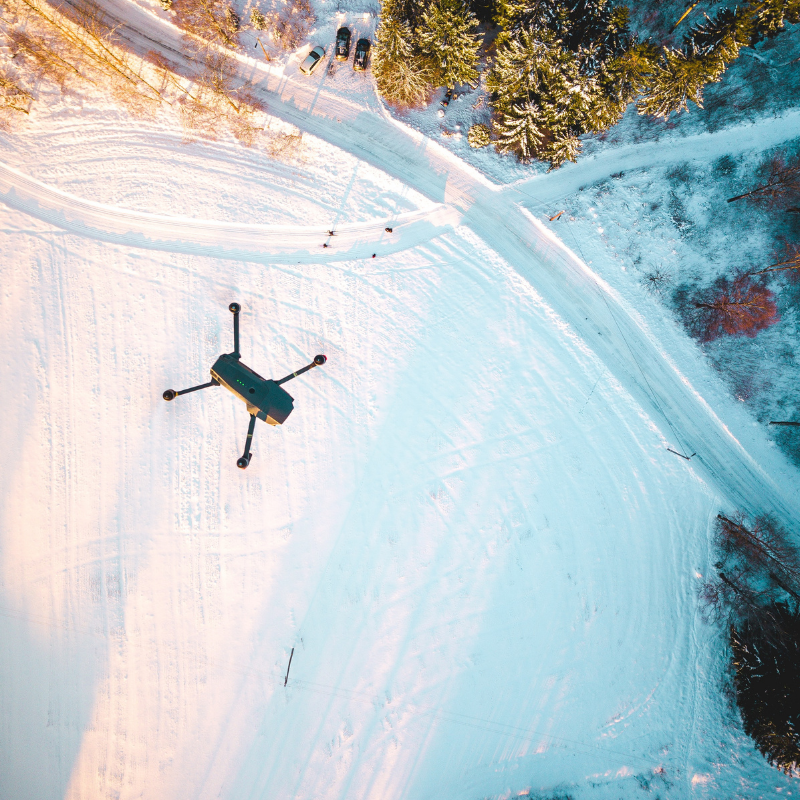
Updated on 9 Oct 2024
Tips for Flying your Drone in Winter
A guide to flying your drone in the winter, including preparation, in-flight tips and photography.
Guide to flying your drone in the winter;
How to prepare your batteries for operating in colder temperatures;
What to consider when planning and preparing your flights;
Should you fly in rain or snow?
Photography tips for winter operation.
Winter brings different challenges when flying your drone, so we've prepared some tips for operating during the colder months.
After all, colder temperatures can affect the aircraft and its batteries, significantly reducing flight time if you’re not careful. Then there's the wind, rain and even snow to think about.
Keep reading for our tips on flying in the winter months to help you avoid any issues.
Flying Your Drone In The Winter: Tips At A Glance
We'll go into more detail throughout this article, but below is an at a glance guide to flying your drone in the winter:
Ensure your batteries are 100% charged before flight.
Keep your batteries insulated before you put them into your aircraft.
Prepare your flight well in advance of takeoff, and in daylight hours.
Check propellers for damage.
Be aware that your propellers can ice over during flight, even if the temperature is above freezing. If this occurs, land your aircraft.
Check weather apps to ensure you will fly in good conditions.
Unless your drone is IP rated, it is not advised to fly in rain or snow. If you fly in these conditions, ensure your equipment is thoroughly dried before packing away.
Never go beyond the capabilities of your aircraft. Understand its capabilities in terms of wind-speed resistance, operating temperature, IP rating and battery life.
Keep an eye on your in-flight app and adhere to any warnings.
Dress appropriately.
Preparing Your Batteries
Charge your batteries to 100% before use. It’s recommended that you don’t fly with old batteries that may be unreliable as colder weather may put stress on them. After all, colder temperatures can result in reduced flight time.
For some aircraft, battery insulation stickers are available to offer additional protection from the cold. As well as keeping your batteries fully charged, make sure you charge your smart device before flight. It may also be affected by cold weather so make sure you monitor it.
Pack the aircraft and batteries in an insulated case when possible to keep the heat in. During transport, keep the equipment in the warmest place available. If you’re in a car, keep it on the back seat rather than in the boot.
When you arrive at your flight location, keep the batteries in pockets close to your body rather than in a cold case.
We recommend that your batteries are 15°C before taking off.
Some DJI models like the Inspire 2, M300 RTK, Mavic 2 Series, and the Matrice 200 series have self-heating function for their batteries for added reliability. Utilise the self-heating function five minutes before putting them into the aircraft.
Keep the weight of your aircraft to a minimum by avoiding any additions you don’t need. This will help give you the maximum out of the aircraft’s batteries in the cold weather. Before your flight, make sure you complete a thorough pre-flight checklist.
Preparation and Transport
Preparation is key every time you fly your drone but particularly important when flying in winter.
Firstly, plan your flight location and any necessary paperwork before you travel in the cold with your drone. We recommend you plan your flight in daylight hours before the cover of darkness sets in, so you know what is within your visual line of sight.
Make an image or video shot list and know what you need before take-off.
Avoid flying in difficult locations such as over water as you may need to land your aircraft at short notice if the temperature drops or it starts raining. And as mentioned before, flight time can be reduced in colder temperatures.
Carefully check your propellers for any damage as the colder weather will put extra pressure on them. If there's even minor damage, don't use them. If you’re prepared for your flight, it will help you avoid difficult situations and unnecessary pressure that adverse weather may cause.
Utilise weather apps to help you plan for hostile weather, such as rain, strong winds or fog.
Avoid Moisture
One of the biggest issues you will face in winter is your aircraft coming into contact with moisture.
First off, use a launchpad for taking off and landing your aircraft. This will help keep your drone dry and avoid mud and dirt.
Unless you have an aircraft like the DJI M200 series with IP43 weatherproofing or an M300 RTK with an IP45 rating, don’t fly in rain or snow.
We understand, flying in snow can create some amazing shots and footage but you are putting your aircraft at risk. If it starts raining or snowing when you’re out flying, you can fly your aircraft backwards to help protect your camera. However, this should only be done if you can do so competently. Try practising when you’re not under pressure to protect your camera.
Remember, clouds also contain moisture so avoid flying into them. Fog also counts as moisture, and it can also limit the distance that you can see your drone.
Once you land your drone, check it over for any moisture including the batteries and camera. Wipe down the aircraft with a towel and ensure it’s completely dry before you pack it away. We advise leaving all the equipment out overnight to dry before packing it away.
Propeller Icing
Especially in the UK, you may think that icing won’t happen but, in colder temperatures, there is a possibility. It doesn’t have to be below 0°C to happen either. Icing is where there’s a build-up of ice on the propellers during flight which can result in prop damage and in extreme cases, a drone crash.
Icing occurs due to a combination of cold temperatures and moisture in the air. Flying in clouds or mist, combined with temperatures below 5°C may cause a build-up of ice. It can occur above 0°C due to the high speed of the propeller reducing the temperature.
Monitor your drone during flight and if you suspect icing is occurring, land immediately and dry your aircraft.
Know Your Drone's Capabilities
Whether it's wind, rain or temperature, it is important that you do not go beyond the operational envelope of your drone.
You can find this information in your aircraft's manual. But to help, the table below is a guide to the capabilities of the most popular DJI models.
Drone | Max Wind Sped (m/s) | Operating Temperature (°C) | IP Rating |
M300 RTK | 15 | -20 to 50 | IP45 |
M200 Series V2 | 12 | -20 to 50 | IP43 |
Inspire 2 | 10 | -20 to 40 | N/A |
Mini 2 | 8.5 to 10.5 | 0 to 40 | N/A |
Mavic Mini | 8 | 0 to 40 | N/A |
Mavic 3 | 12 | -10 to 40 | N/A |
Air 2S | 10.7 | 0 to 40 | N/A |
Air 2 | 8.5 to 10.5 | -10 to 40 | N/A |
P4 RTK | 10 | 0 to 40 | N/A |
P4 Pro V2.0 | 10 | 0 to 40 | N/A |
Mavic 2 Series (inc Enterprise Series) | 8 to 10.5 | -10 to 40 | N/A |
DJI FPV | 10.8 to 13.6 | -10 to 40 | N/A |
Drone Flight
During your flight, the main areas you will need to pay attention to are the battery temperature and voltage - and you can check these in your flight app.
Make sure you stay in the recommended battery temperature range found in your aircraft’s user manual. For the battery voltage, this will show in green, amber or red.
If the battery voltage colour goes red or drops below 3.2, land the aircraft immediately.
As soon as you take off the aircraft, hover for around 60 seconds at a maximum of 10 feet.
Monitor the behaviour of the aircraft, the battery and the app to ensure their performance is normal.
During your flight, try to fly your aircraft with smooth and gentle movements. This will help conserve the battery and not waste your power. It’s also worth noting, colder temperatures result in the air being denser. This means your aircraft will be more responsive, especially if you’re flying below 0°C.
Be careful when flying in these conditions if you’re not used to it. As well as watching out for precipitation, high winds can be more common in the winter months.
Check the wind speed before your flight to ensure your aircraft is suitable to fly. When winds are high, fly with caution, especially if you’re not used to these conditions.
Additionally, you should pay attention to all warning messages on your app. Follow any advice given to you by the app and land if you’re prompted to do so.
Finally, limit your flight time compared to your usual flight. Don’t run your battery down until it's empty. Land the aircraft and check it as we discussed above to ensure there are no issues.
Images and Video
Winter and especially snow can be the backdrop to some stunning videos and images. However, you need to be aware that if you’re not using the auto functions, your camera settings will need to be changed to get the best results.
Shooting in snow will require you to increase your exposure for the best images. Test out different apertures, shutter speeds and your ISO dependent your style and the light available. You will also need to take into account the white balance of your image if you’re shooting in JPEG.
If you can’t get the right colouring in the standard settings, try different custom settings. For more information on drone camera settings, head to our previous Heliguy Insider post here. You may also benefit from using an ND filter in winter and snowy conditions. This can help you with the bright light and reflected light from the snow.
Dress Appropriately
You need to ensure what you’re wearing is right for flying. Make sure you wear plenty of layers and a coat to keep yourself warm.
You don’t want to get your drone up in the air to realise you’re freezing and have to bring it back down again to put a coat on.
The most beneficial item of clothing for drone pilots in winter is gloves. Your hands will be out in the open for the entire time you’re flying so make sure you have a pair of gloves on that won’t interfere with your flying ability.
We recommend using a pair of touchscreen gloves, so you can still access your device during flight.
Summary
The main things you need to do when flying in winter are; be sensible, limit your flight time, keep a close eye on your aircraft and the app you’re controlling it with, and stay warm yourself.
Make sure to read the manual for your aircraft and stay in its parameters for temperature etc.
Don’t avoid flying altogether. Winter is a great time of year for taking some unique shots from a different perspective. Following the tips above and staying within your capabilities as a pilot will keep you and your aircraft safe.

written by
James Willoughby
James joined heliguy™ in 2018 following a 13-year stint in print and online journalism, having worked on regional and weekly newspaper titles. He is responsible for spearheading heliguy™'s content strategy and social media delivery. James collaborates with DJI Enterprise's European marketing team to coordinate and produce case studies and helps organise events and webinars.